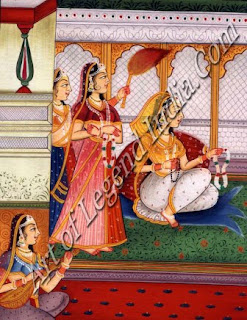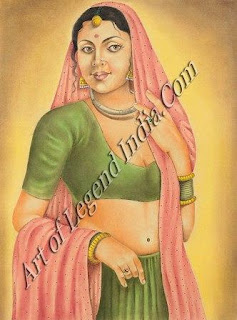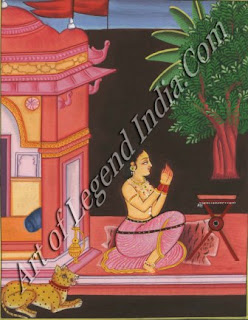Rajasthani
painting occupies its own historical place in Indian painting. From the time of
its origin it emerged and flourished and has been part of the continuing
traditional wave of painting in India since ancient times. Parameters regarding
early and later developments of painting from time to time could be detected in
it. It is a different matter that it unhesitatingly assimilated the impact of
other Indian as well as foreign styles in this period.
Constitution of Rajasthani School
Rajasthani
painting developed in various styles of the Mewar, Marwar, Hadoti and Dhundar
schools, and their substyles from the 16th century to the 19th is definitely a
major branch of Indian painting. Greatly influenced by other schools and
styles, the identity of Rajasthani painting could easily be ascertained. It
possesses the following main characteristics.
1.
Depiction of Folklife: Rajasthani painting
developed in a tradition of frescoes strictly confined to folklife. In early
paintings simplicity and ease and abundance of sentiment relating to folklife
in selecting colour schemes and themes have been noted. Art flourished in the
cultural milieu of the royal court, and this painting was dissociated from the
folk element. Developed at religious and cultural centres, this style of painting
was closely associated with public life and popular themes.
2.
Abundance of Pravants: Rajasthani painting is
full of romance. A sentimental approach had been extensively adopted in this
style. The sweet Radha-Krishna theme has been used extensively and is deeply
rooted in it. A rare combination of Bhakti and shringar has been depicted in a
lively manner in Rajasthani painting.
3.
Variety
of Themes: The subject matter of Rajasthani painting is vast. It flourished on
the background of many themes like the various lilas of Radha-Krishna, stories
relating to the Mahabharat and Bhagwad, nayak-nayika-bheda, rag-ragini,
barah-masa, description of seasons, court life, festivals, hunting, draw-ings
of raja-rani, folklore. Illustration of poetry is a unique characteristic of
this style.
 4.
Colour-Scheme: Arrangement of colour in
Rajasthani painting is specially significant. Red, yellow, white and green are
the principal colours of this style. With combinations of these colours artists
made paintings in technicolour. Application of sharp bright shining colours
possess their own form and style.
4.
Colour-Scheme: Arrangement of colour in
Rajasthani painting is specially significant. Red, yellow, white and green are
the principal colours of this style. With combinations of these colours artists
made paintings in technicolour. Application of sharp bright shining colours
possess their own form and style.
5.
Raiput Culture: Lively depiction of Rajput
culture and civilisation and the circumstances of that age is often visible in
Rajasthani painting. Their skill as builders of forts and temples, have/is,
royal courts has been minutely shown in Rajasthani painting. Traditional and
devotional ages have also been extensively painted in a lively style.
6.
Nature's Perspective: The vast perspective of
nature has been painted in many colours. There are ponds full of lotus flowers.
Rays of serpentine lightning in a sky covered with dense black clouds, forests,
gardens, trees, shrubs, flowering plants, leaves, fields full of birds, deer,
peacock, lion, elephant, these are special features of Rajasthani painting.
Comparison with Equivalent Schools of North
India
For the
sake of comparison, two schools of northern painting could be placed on a level
with Rajasthani painting. These are the Mughal and Pahari schools. One
conclusion to be drawn from a comparative study is that the Rajasthani style,
though influenced by these styles, still maintained its originality.
Rajasthani and Mughal Schools
Origin
and development of these schools took place simultaneously. Because of
political and other influences mutual artistic exchange is quite natural, but
both these styles retain their original characters. The Mughal style is based
on the Iranian school and the Rajasthani on an indigenous style.
Regarding
subject matter, the Mughal style was dominated by the pomp and show of the
royal court and of feudal lords, the Rajasthani on the other hand by the
simplicity of folklife. The Mughal style had a realistic approach while the
Rajasthani style adopted a highly imaginative posture.
The
Mughal style emerged from miniatures while the Rajasthani style grew from
frescoes. While one was dominated by the grandeur of the royal court, the other
was filled with religious sentiment, devotion and shringar. In one drawing of
the court, wars and royal festivals was extensively depicted, in the other
there was lively depicting of a simple rural lifestyle, romantic poetical
imagination, religious sentiment and enactments of various moods of
Radha-Krishna. One contained a graphic account of Persian poetry and Mughal
history, while the other depicted nature in depth on the basis of texts from
Hindi-Sanskrit poetry.
In
Rajasthani painting colour schemes and style of decoration are entirely
different from those of the Mughal style. While the colour scheme of one was
austere, the other acquired a lively character. Rajasthani painting assimilated
the Puranic tradition of ideal Hindu life, deeds of Rajput chivalry and culture
while the other style was predominantly Mughal in character. One used Indian
symbols like the lotus, swan and peacock while the other was dominated by trees
of saru, falcons and camels.
A
comparative examination of these styles reveals the diversity of sentiment in
them. From the middle of the 16th century, because of the political and social
impact of the Mughals, the seeds of Mughal culture spread in Rajasthan. By the
beginning of the 17th century the whole of Rajasthan came under the
influence of the Mughals. They established their cultural suzerainty over the
whole of Rajasthan, and at the same time were tremendously influenced by the
Rajputs themselves. Matrimonial alliances between Mughals and Rajputs resulted
in mutual exchanges in the arts, and this is clearly visible in these styles.
Rajasthani and Pahari Schools
The
style of painting which flourished in Basohli, Jammu, Garhwal, Chamba, Kangra,
Guler and Mandi in the hilly areas in the northwest has been termed the Pahari
school. Developed in the 18th century, this style is an eternal legacy of the
Rajasthani style. With the eclipse of Mughal art some artists from the Mughal
court were sheltered by Rajput royalty. Under the impact of environment the
paintings they produced acquired the name of new Pahari school.
 Pahari
painting, like the earlier Rajasthani style, adopted the same parameters for
drawings of sentiment and artistic portrayal. On the basis of expressing
different moods of Rad ha-Krishna many paintings were drawn in the Pahari
style. Paintings executed on the basis of texts like Bhagwad-Puran,
Geet-Govind, Sursagar, Rasikpriya, Bihari-Satsai, nayika-bheda and rag-ragini
are the main heritage of the Kangra and Basohli styles. In the Basohli style,
like the Mewar style, indicative colours and folk art predominate. In the
Pahari school of painting, expression of sentiment, rhythm in line and colour
and diversity of subject matter are unique in the Kangra style.
Pahari
painting, like the earlier Rajasthani style, adopted the same parameters for
drawings of sentiment and artistic portrayal. On the basis of expressing
different moods of Rad ha-Krishna many paintings were drawn in the Pahari
style. Paintings executed on the basis of texts like Bhagwad-Puran,
Geet-Govind, Sursagar, Rasikpriya, Bihari-Satsai, nayika-bheda and rag-ragini
are the main heritage of the Kangra and Basohli styles. In the Basohli style,
like the Mewar style, indicative colours and folk art predominate. In the
Pahari school of painting, expression of sentiment, rhythm in line and colour
and diversity of subject matter are unique in the Kangra style.
From
the point of view of development of art, the contribution of Raja Sansar Chand
(1775-1783) was invaluable. In respect of steadiness of brush, selecting
colours, pleasing figures of males and females, drawing of nature in seven
colours, diversity in animals and birds and expression of sentiment, the Kangra
style is much renowned. Application of seven colours and beauty prevalent in
Bundi and Kishangarh styles is particularly noticeable in the Kangra style.
This similarity in the Pahari and Rajasthani schools are two strains of the
traditions of Indian painting.
 The
Rajasthani school of painting and other earlier and later styles of Indian
painting influenced each other to such an extent that it becomes an uphill task
to dissociate them.
The
Rajasthani school of painting and other earlier and later styles of Indian
painting influenced each other to such an extent that it becomes an uphill task
to dissociate them.
The
great significance of Rajasthani artists adopting the rich traditions of Indian
painting, of which the most artistic is the Ajanta style, cannot be denied.
Originating at Medpat (Mewar) and greatly influenced by earlier styles and
substyles and adopting later styles, Rajasthani painting greatly enriched
Indian art.
Owing
to the folk-artistic impact of the Mewar style, total drawing of integrated
seven colours in the Bundi and Kishangarh styles, the Mughal influence on the Jaipur
and Alwar styles, whatever draft of Rajasthani painting emerges before us, has
been commented on by Dr Coomaraswamy like this: "It is a highly fine form
of Indian painting and deserves its unique position among all great styles of
the world." Different enactments of moods of Rad ha-Krishna form the basis
of drawings of this style. Based on Hindi, Sanskrit and Rajasthani poetry, this
style of painting turned medieval culture and civilisation and sentimental
aspects of Hindi poetry dedicated to Lord Krishna into reality.
Rajasthani
painting is the lively reflection of the literature of Hindu society.
Rajasthani artists applied colours magically. Their unique method of
description lends pleasing comfort to the eyes. Their paintings possess an
eternal source of romance.
Pictorial
texts and miniatures created by them could not only be applied in studying the
sentimental and artistic aspects of medieval literature, but could also be
utilised in viewing the true form of the whole culture of that age. Hence
Rajasthani painting occupies a unique and very significant place in the history
of Indian culture in the Mughal and post-Mughal periods.
Writer – Jai Singh Neeraj
 4.
Colour-Scheme: Arrangement of colour in
Rajasthani painting is specially significant. Red, yellow, white and green are
the principal colours of this style. With combinations of these colours artists
made paintings in technicolour. Application of sharp bright shining colours
possess their own form and style.
4.
Colour-Scheme: Arrangement of colour in
Rajasthani painting is specially significant. Red, yellow, white and green are
the principal colours of this style. With combinations of these colours artists
made paintings in technicolour. Application of sharp bright shining colours
possess their own form and style.  Pahari
painting, like the earlier Rajasthani style, adopted the same parameters for
drawings of sentiment and artistic portrayal. On the basis of expressing
different moods of Rad ha-Krishna many paintings were drawn in the Pahari
style. Paintings executed on the basis of texts like Bhagwad-Puran,
Geet-Govind, Sursagar, Rasikpriya, Bihari-Satsai, nayika-bheda and rag-ragini
are the main heritage of the Kangra and Basohli styles. In the Basohli style,
like the Mewar style, indicative colours and folk art predominate. In the
Pahari school of painting, expression of sentiment, rhythm in line and colour
and diversity of subject matter are unique in the Kangra style.
Pahari
painting, like the earlier Rajasthani style, adopted the same parameters for
drawings of sentiment and artistic portrayal. On the basis of expressing
different moods of Rad ha-Krishna many paintings were drawn in the Pahari
style. Paintings executed on the basis of texts like Bhagwad-Puran,
Geet-Govind, Sursagar, Rasikpriya, Bihari-Satsai, nayika-bheda and rag-ragini
are the main heritage of the Kangra and Basohli styles. In the Basohli style,
like the Mewar style, indicative colours and folk art predominate. In the
Pahari school of painting, expression of sentiment, rhythm in line and colour
and diversity of subject matter are unique in the Kangra style.  The
Rajasthani school of painting and other earlier and later styles of Indian
painting influenced each other to such an extent that it becomes an uphill task
to dissociate them.
The
Rajasthani school of painting and other earlier and later styles of Indian
painting influenced each other to such an extent that it becomes an uphill task
to dissociate them. 















Admiring the Beauty of Rajasthani Paintings
I absolutely love the intricate and vibrant art style of Rajasthani paintings! Each piece tells a unique story, whether it's the detailed miniature paintings or the bold colors seen in traditional wall art.
I’ve had the chance to visit Udaipur and Jaipur, and the local art galleries there are full of these stunning paintings. I was particularly amazed by the Mewar and Marwar styles, which showcase the royalty and history of Rajasthan through beautiful depictions of court scenes, animals, and nature.
The use of natural colors like minerals and gold leaf in Rajasthani art makes each painting feel like a treasure. What struck me the most was the delicate attention to detail in the pichwai paintings, which often depict the stories of Lord Krishna. If anyone is visiting Rajasthan, I highly recommend purchasing some smaller artworks or even attending a workshop to learn more about the art form. It’s an experience that connects you to Rajasthan’s rich cultural heritage. 😊
Thanks for sharing this blog and the gorgeous images of Rajasthani paintings! It’s a great way for art lovers to appreciate the diversity and depth of Indian art. ✨
Luxury Taj Mahal Tour
Luxury Golden Triangle Tour